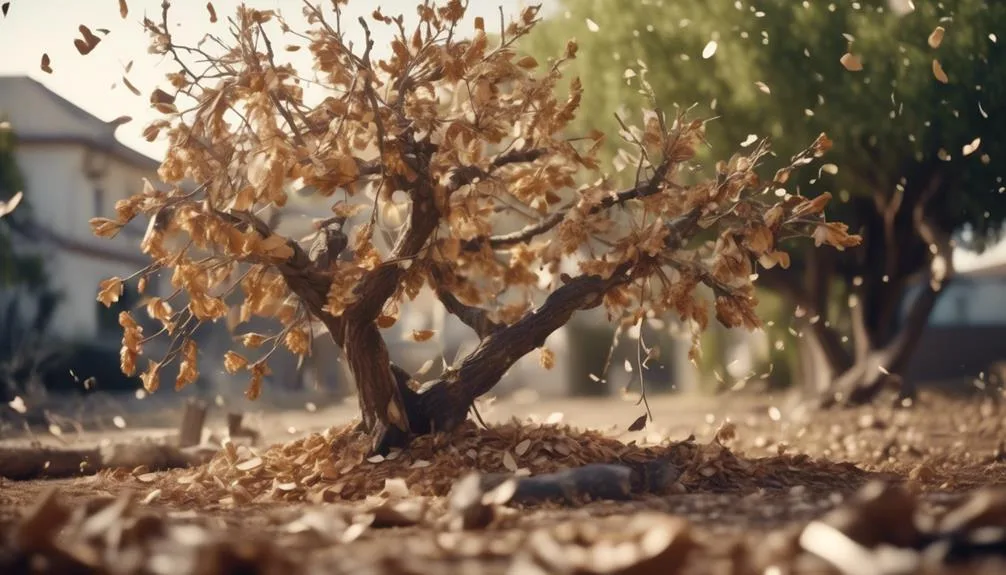Strong winds can wreak havoc on almond trees, despite their resilience. The damage from gusts can harm the trees' health and productivity.
It's important to understand the signs of wind damage and how to protect your almond trees. Let's explore how high winds can affect almond trees and learn ways to prevent and recover from this type of damage.
Key Takeaways
- Almond trees are vulnerable to wind damage due to their delicate branches and blossoms.
- Wind resistance properties, such as flexible branches and deep root systems, help almond trees withstand high winds.
- Proper pruning, installing windbreaks, and supporting young trees can prevent wind damage to almond trees.
- In the event of wind damage, trimming broken branches, strengthening the roots, and closely monitoring tree health can aid in recovery.
Impact of High Winds on Almond Trees
When high winds strike, almond trees may suffer damage to their delicate branches and blossoms, impacting their ability to produce a healthy harvest.
Root stability plays a crucial role in helping almond trees withstand high winds. Well-established and deep root systems contribute to the stability of the trees, helping them anchor firmly in the soil and resist being uprooted during strong winds.
Additionally, wind resistance properties are essential for almond trees to endure high winds. These properties include features such as flexible branches and the ability to bend without breaking, reducing the risk of damage. Almond trees with good wind resistance properties can better withstand the impact of strong winds, preserving their branches and blossoms and ultimately ensuring a more fruitful harvest.
Vulnerability to Wind Damage
Almond trees are particularly susceptible to wind damage due to their delicate branches and blossoms, which can be easily affected by strong gusts. To illustrate, the delicate nature of almond tree branches and blossoms makes them prone to breakage and loss during high winds, potentially leading to decreased productivity. To mitigate this vulnerability, it is essential to consider wind resistant tree species and wind damage prevention techniques.
| Wind Resistant Trees | Wind Damage Prevention Techniques |
|---|---|
| Bald Cypress | Proper pruning to reduce wind sail |
| Live Oak | Installing windbreaks |
| Red Maple | Staking young trees |
| Eastern Redbud | Supporting branches with braces |
| Southern Magnolia | Using guy wires for support |
Choosing wind-resistant tree species and implementing effective wind damage prevention techniques can significantly reduce the impact of high winds on almond trees, ultimately promoting a healthier and more productive orchard.
Signs of Wind Damage on Almond Trees
Noticing signs of wind damage on your almond trees requires careful observation and prompt action to ensure the health and productivity of your orchard. Look for the following indicators of wind damage:
- Broken Branches: Check for any branches that may have snapped or twisted in the wind.
- Leaning Trees: Assess if any trees have been uprooted or are leaning at an unusual angle.
- Torn Leaves: Look for torn or tattered leaves, which can signify wind damage.
- Bark Damage: Inspect the tree trunks for any signs of abrasions or scrapes caused by high winds.
- Fruit Loss: Monitor for any loss of developing almonds due to wind-induced stress.
Regularly monitoring and addressing these signs of wind damage is crucial for the overall health of your almond trees and orchard. Proper tree maintenance and timely interventions can help mitigate the effects of wind damage and ensure a thriving almond crop.
Preventing Wind Damage to Almond Trees
To protect your almond trees from wind damage, implementing effective preventive measures is essential for maintaining their health and productivity. Consider wind resistant planting and proper pruning techniques to safeguard your almond trees.
| Preventive Measures | Description | Benefits |
|---|---|---|
| Windbreaks | Planting windbreaks such as shrubs or trees around your almond orchard to reduce wind speed and protect the trees from strong gusts. | Minimizes wind damage and maintains tree structure. |
| Tree Spacing | Properly spacing almond trees can help reduce wind damage by allowing air to flow more evenly through the orchard, reducing the impact of strong winds. | Promotes better air circulation and decreases the risk of tree breakage. |
| Selective Pruning | Regularly prune almond trees to remove dead or weak branches, promoting a stronger tree structure that can better withstand high winds. | Enhances tree health and resilience against wind damage. |
Implementing these measures can significantly decrease the risk of wind damage to your almond trees, ensuring their long-term health and productivity.
Recovering From Wind Damage
After a severe wind event, assessing the extent of the damage to your almond trees is crucial for developing an effective recovery plan.
Here are the steps you should consider to help your almond trees recover from wind damage:
- Trim and repair broken branches to promote new growth and prevent further damage.
- Strengthen the roots by gently loosening the soil around the base of the tree and adding a layer of mulch to retain moisture and provide stability.
- Water the trees deeply and regularly to support their recovery process.
- Monitor the trees closely for signs of stress or disease, and take appropriate action if needed.
- Consider consulting with a professional arborist for advice on supporting the recovery of your almond trees.
Conclusion
In summary, high winds pose a significant threat to almond trees, causing damage such as broken branches and uprooted trees.
It's crucial for almond tree growers to be mindful of this vulnerability and take preventive measures to protect their trees.
By recognizing the signs of wind damage and implementing recovery efforts, growers can safeguard the health and productivity of their almond trees.
Ultimately, understanding and addressing the impact of high winds on almond trees is essential for ensuring their long-term well-being and sustainability.

